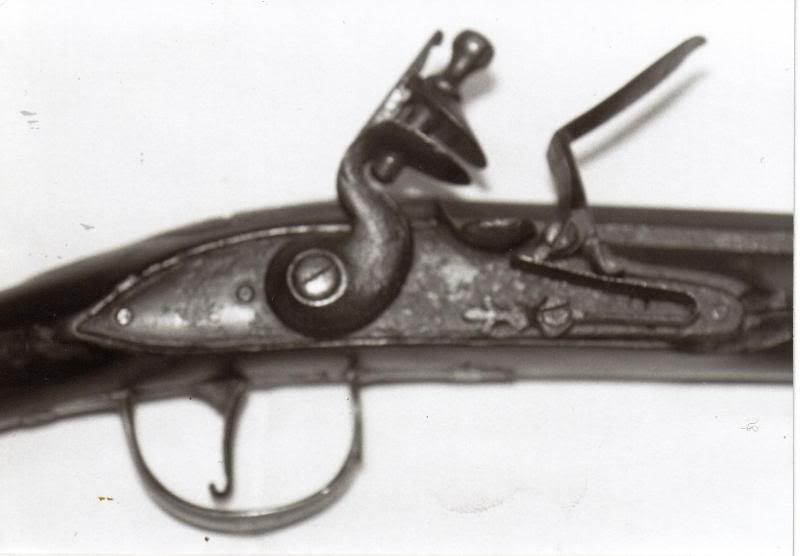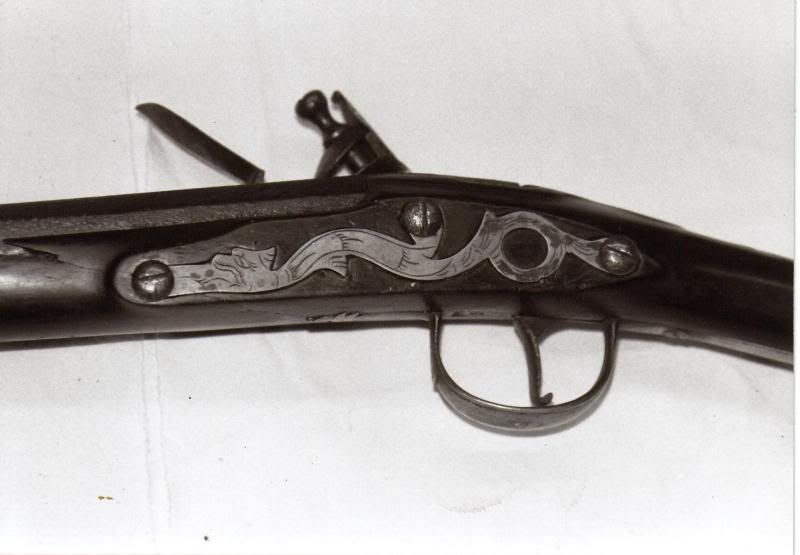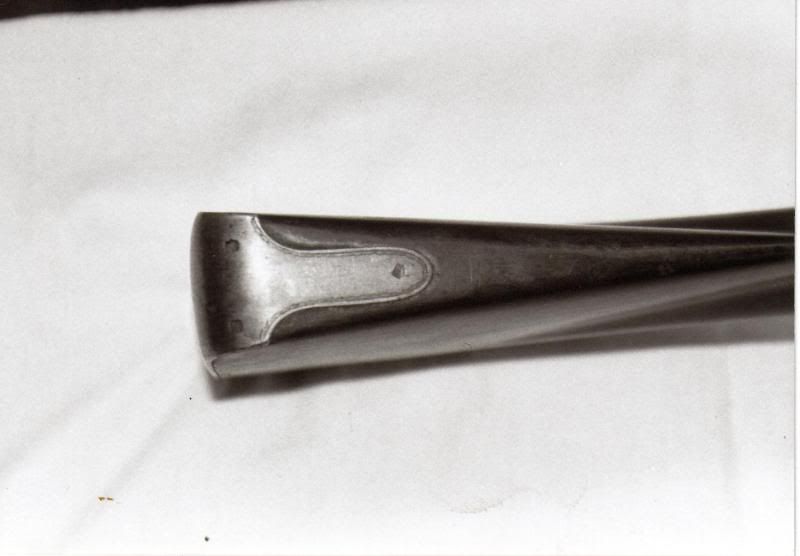razorbritches,
I want to commend you on your effort. I also want to commend you for the courage in asking for a real critique. You have taken tools in hand and have made a fine accomplishment. You have created something you can be proud of and you know how much hard work is in building a gun.
For the hard work you have done, the great effort expended and the fact you asked for an honest critique so you can grow as a builder is why I post the following. Through this; hopefully you, other readers and I can grow in this craft.
You chose to build a gun based on the Early English Trade gun, known as Hamilton's Type G. I know you were making your own version but comparing yours to the original will help in this critique.
Lets start with the main components, lock, stock and barrel.
Lock You chose the medium sized Siler Germanic/American lock. This rifle sized lock is a good one but it is not the best choice for this build. It's mainly due to it's size. It's just too small for the context of this build.
Stock You chose black cherry in the English trade gun pattern. What hurts you with this stock pattern choice is the lock and barrel. Another major factor here is web of the ramrod. It appears you are using a very thick rod. 7/16? 1/2? It also appears that the web of wood between the barrel channel and ramrod hole is very large.
Barrel You chose a barrel with a narrow breech and little to no taper.
These core components and their relationship to each other kind of cripples the architecture from the start.
The bottom line here is you built a large locked, large barreled gun with a small lock and small barrel with a stock built in the same scale as the larger components or even bigger considering the ramrod web.
So the choice of these hamstrings you from the start. This could have worked better if you had scaled down the stock to better fit the chosen components and had a very small web between the barrel channel and ramrod hole.

Above we can see that the barrel has no taper. Note the tang area behind the breech, notice how the light outlines a flat area on either side of the tang. Note too the wood directly behind the breech in the sideplate corner this area needs to be rounded better so it will flow into the wrist. If it was rounded better it would bring the top of the lock panels down. Note too how in the sideplate side of the stock the barrel appears to be buried. I'll come back to this later. The work is excellent in this view of the lock panels. The width of the forestock and how it meets the barrel is near perfect. Engraving very good.

At this view the light really highlights the flat area from the bow of the trigger guard forward into the forestock this flat area appears to go on to a point of the the picture further down on the lower fore stock. This flat area will show up later.
What would have really helped here would have been to round the belly of the stock. The triggerguard finial could have been shaped to match the roundness of the belly. Rounding the belly could have reduce the size of the lock panels, we'll visit this in a moment.
I think the screw heads should be domed a little.
The overall view is good the size of the wrist, it's relation to the forestock and the size of the panels look good from this angle.
Engraving, good.
One thing that looks odd in this view that you might miss is the lock's relationship here to the triggerguard bow. Think on that for a moment.
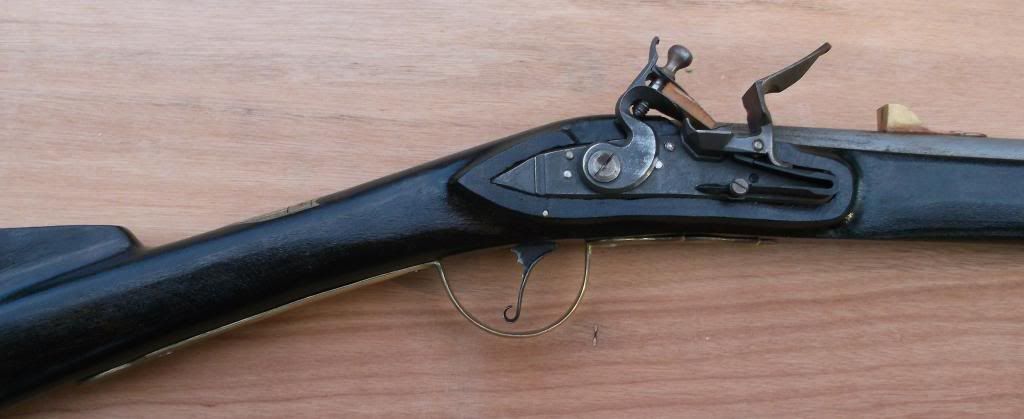
O.K. The reason that the trigger bow and lock looked odd from the bottom becomes apparent here. This is by far this gun's major flaw and it could affect function. The trigger is set too far to the rear. It also pinned too low It needs to come forward maybe even a 1/4 of an inch. Looking at the trigger it hangs in close to the pulled position. Trigger pull would be much better if it were pinned higher and forward. Of course this would mean moving the TG forward also.
This is where that small lock comes back to haunt.
But there is something else going on here. Even if the belly is rounded, the trigger moved forward, what's happening here?
The answer... This area of the stock is simply too big. Even with a proper trade or fowling lock it would still be too big. That's a large siler and it looks like a small one.
The reason, the web between the rod and barrel is too large for good slim trade gun architecture. The rod is very large too; that's one reason the trigger pinned the way it is. The lower forestock from ramrod entry is not like a slim trade gun, it's more like a heavy musket. The Siler just exacerbates that flaw of architecture. It would look much better if the lower forestock was rounded but, it is what it is.
Here is another architectural factor here in this area. Note how the tail of the lock panel where it ends in the wrist disrupts the flow. It actually looks higher than the tail of the lock. What happened here is the tail of the lock and the tail of it's panel are in the same level plane. The tail of the lock panel should be more to the center of the wrist. If it were it would flow a lot better.
At the very top of the stock straight above the cock bolt there appears to be a hump. If the tang was bent a little better into the wrist this hump would have been eliminated.
Another factor from the top, if the wood was rounded down to meet the top of the lock making the lock panel smaller it would look much better.
Overall here the lock panels are way too large especially for the mid 18th Century for which this gun is based.
This is a Wilson Type G. Note how small it is from tang to belly. Note the trigger placement. Note how very small the lock panels are. It almost has no lock panels except towards the front and rear.
Note too how the wood at the top comes down from the tang to meet the top of the lock.
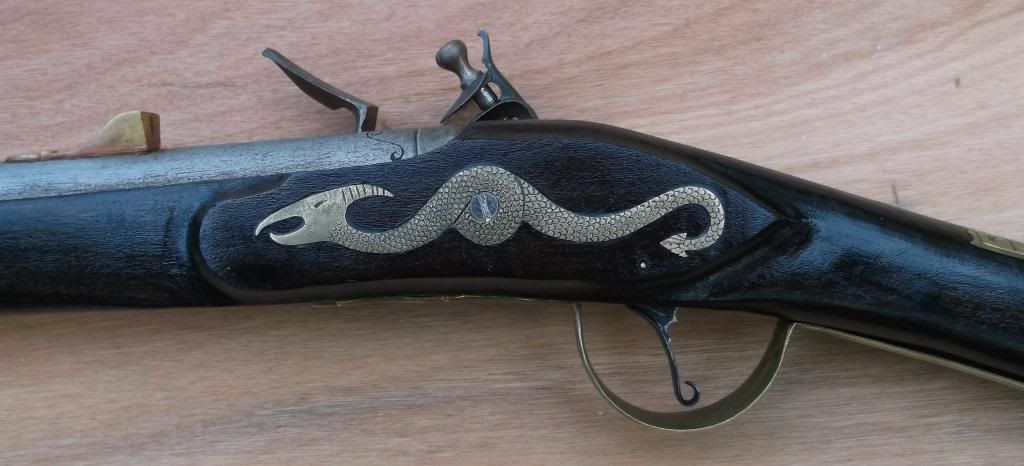
What stands out here is that cool a$$ side plate. I dig it and I commend you for it. It's fun and I like it. This is where your personality comes out, it's artsy in folk art way.
More of the same here. Note the hump behind the tang it's clearer in this view. Just above the trigger the light shows a flat area.
Here is a tip about architecture. Note how the barrel is revealed from the nose of the lock panel to the breech. More barrel is covered by the wood as it approaches the breech.
In original work the opposite is true. As the barrel approaches the breach in most 18th Century rifles and guns more of the barrel is revealed. Revealing more of the barrel here allows you to bring the lock panels down lower. It also allows you to shape the wood behind the breech to mimic the barrel eliminating the extra wood I mentioned in the first picture.
Another thing that stands out is the flat slotted screw. For a lock nail it should be a domed screw. It just looks too modern.
The single lock bolt says 1820 instead of 1760.
I like the side plate but think how well you could have pulled off the original serpent type.
Look at how this Wilson Trade Gun's lock panel flows into the wrist. Note how it's in the center. See what I mean?
Look how the top comes down to meet the top of the panel. Note how tight the wood is at the breech of the barrel. Note the screws.
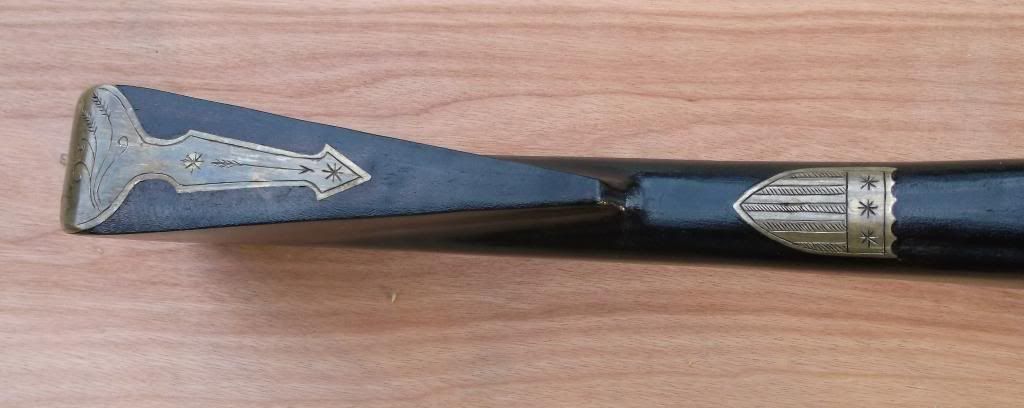
Compare...
The shield is is Federal era, looks real good.
Engraving good I like it.
Where does this gun stand as a historical piece? Since it has a single lock bolt, and the federal shield I would say it could be a circa 1815-20 made gun a re-stock or possibly a talented blacksmith or apprentice made gun. It's fun.
It's obvious you have a lot of talent to build that one from a blank. I's raw but you have the talent.
It may have been a little unfair for me to compare it to an original Wilson. England at the time had the best gunmakers in the world and even their cheap trade guns were good.
IMHO you need to study and actually feel and handle original or good contemporary guns to get the eye. I can tell you did some study but pay closer attention to the images, note how the light reflects the curves and shapes.
The G is my favorite gun.
Cherry is my favorite wood. With that said my only real dislike of your build is the stain. Cherry is such a pretty wood it needs no stain at all. A lye treatment would have turned it red. Simply shellacked and varnished with an oil finish it would have turned dark on it's own.
If you can make the trip, in November come to Fort Toulouse Ft Jackson Park Frontier Days in Wetumpka Alabama just North of Montgomery on US Hwy 231. There you can see plenty of Type Gs. Maybe my son's will be in by then. I'll be in the 1814 Tennessee camp.
Travis Brown




